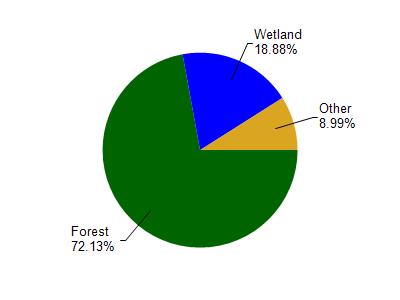Langlade
Yes
Yes
No
Fish and Aquatic Life
Overview
Un Creek (T34n-R10e-S24), in the Lily River Watershed, is a 3.11 mile river that falls in Langlade County. This river is an outstanding/exceptional resource water under NR102 as well as a Class I Trout Water under the Fisheries Program. This river is managed for fishing and swimming and is currently not considered impaired.
Date 2011
Author Aquatic Biologist
Condition
Wisconsin has over 84,000 miles of streams, 15,000 lakes and milllions of acres of wetlands. Assessing the condition of this vast amount of water is challenging. The state's water monitoring program uses a media-based, cross-program approach to analyze water condition. An updated monitoring strategy (2015-2020) is now available. Compliance with Clean Water Act fishable, swimmable standards are located in the Executive Summary of Water Condition in 2018. See also the 'monitoring and projects' tab.
Recommendations
Habitat Restoration - Instream
The Town of Elcho is sponsoring a project to restore aquatic connectivity to the Hunting River. Project final deliverables include: Post construction monitoring would occur to document changes in water levels and flows after the new road crossing is installed. Success would be documented in part by comparing the water velocities, flow characteristics, and riverbed composition at the new road crossing to make sure they match the conditions in the natural river channel at a natural reference reach beyond the influence of the road. A stream and water elevation profile would also be tied to the local benchmarks to document the elimination of the impounding condition as well as culvert perch to allow for reestablishment of natural channel morphology and sediment transport. Instream water monitoring device data would also be evaluated to document any changes in upstream water temperatures. Specific project activities include: To design a road stream crossing that will meet the deliverables above and to replace the current culverts with an adequately sized and set road crossing during the 2016 field season.
Restore Hydrology, Morphology
The Town of Elcho is sponsoring a project to restore aquatic connectivity to the Hunting River. Project final deliverables include: Post construction monitoring would occur to document changes in water levels and flows after the new road crossing is installed. Success would be documented in part by comparing the water velocities, flow characteristics, and riverbed composition at the new road crossing to make sure they match the conditions in the natural river channel at a natural reference reach beyond the influence of the road. A stream and water elevation profile would also be tied to the local benchmarks to document the elimination of the impounding condition as well as culvert perch to allow for reestablishment of natural channel morphology and sediment transport. Instream water monitoring device data would also be evaluated to document any changes in upstream water temperatures. Specific project activities include: To design a road stream crossing that will meet the deliverables above and to replace the current culverts with an adequately sized and set road crossing during the 2016 field season.
Management Goals
Wisconsin's Water Quality Standards provide qualitative and quantitative goals for waters that are protective of Fishable, Swimmable conditions [Learn more]. Waters that do not meet water quality standards are considered impaired and restoration actions are planned and carried out until the water is once again fishable and swimmable
Management goals can include creation or implementation of a Total Maximum Daily Load analysis, a Nine Key Element Plan, or other restoration work, education and outreach and more. If specific recommendations exist for this water, they will be displayed below online.
Monitoring
Monitoring the condition of a river, stream, or lake includes gathering physical, chemical, biological, and habitat data. Comprehensive studies often gather all these parameters in great detail, while lighter assessment events will involve sampling physical, chemical and biological data such as macroinvertebrates. Aquatic macroinvertebrates and fish communities integrate watershed or catchment condition, providing great insight into overall ecosystem health. Chemical and habitat parameters tell researchers more about human induced problems including contaminated runoff, point source dischargers, or habitat issues that foster or limit the potential of aquatic communities to thrive in a given area. Wisconsin's Water Monitoring Strategy was recenty updated.
Grants and Management Projects
Monitoring Projects
| WBIC | Official Waterbody Name | Station ID | Station Name | Earliest Fieldwork Date | Latest Fieldwork Date | View Station | View Data |
|---|
|
|

Watershed Characteristics
Unnamed is located in the Lily River watershed which is 209.47 mi². Land use in the watershed is primarily forest (72.20%), wetland (18.90%) and a mix of open (4.20%) and other uses (4.80%). This watershed has 161.31 stream miles, 4,248.79 lake acres and 18,178.21 wetland acres.
Nonpoint Source Characteristics
This watershed is ranked Not Ranked for runoff impacts on streams, Not Ranked for runoff impacts on lakes and Low for runoff impacts on groundwater and therefore has an overall rank of Low. This value can be used in ranking the watershed or individual waterbodies for grant funding under state and county programs.However, all waters are affected by diffuse pollutant sources regardless of initial water quality. Applications for specific runoff projects under state or county grant programs may be pursued. For more information, go to surface water program grants.